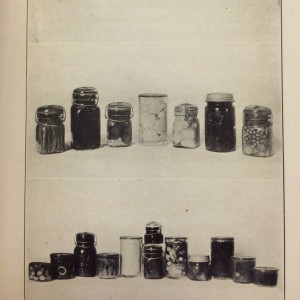Canning vegetables
by olivia law
After the short introduction, where Mrs Andrea discusses seasonality of different produce and the most effective ways of picking and storing the vegetables. There are photos of Mrs Andrea using canning equipment, in which she is dressed somewhat reminiscent of a nurse.
The 19 page list of vegetables covered in the book is organized alphabetically, and there are very specific instructions to each vegetable. Three types of corn are mentioned, and the difference between French artichokes and ‘regular’ artichokes are also highlighted.
A clear scientific knowledge is demonstrated here — knowledge obtained through the cookery school, in which Mrs Andrea explains that a preliminary cooking ruptures the starch-cells of the corn, making better-flavoured vegetables.
Some interesting inclusions:
Chayote: an edible plant belonging to the gourd family, along with melons, cucumbers and squash. Mrs Andrea describes the chayote as a “comparatively new vegetable,” which demonstrates the relative modernity of her publishing.
Dandelion, endive and kale: all considered today as “superfoods,” but here grouped under the same category as spinach. Kale is considered to be closer to the cabbage family, but in Mrs Andrea’s instructions, cabbage is to be canned in the same manner as Brussels sprouts. It is also native to the Mediterranean, and likely to be unavailable fresh for Mrs Andrea’s North American readers.
Salsify: (Oyster plant) a common wildflower, also native to the Mediterranean but has since been introduced to southern England, North America (where its flowering seasons are longer in southern states such as California) and southern Africa. Apparently quite in fashion during the Victorian era, salsify’s appeal had dwindled by the 20th century and today is mainly found in speciality stores.
There are also instructions for combining different vegetables – carrots and peas, corn and green peppers, corn and tomatoes, succotash (which is a salad made from corn and lima beans.) Within this section are photographs in black and white of cans and jars made from the recipes given – never underestimate the power of photos.
